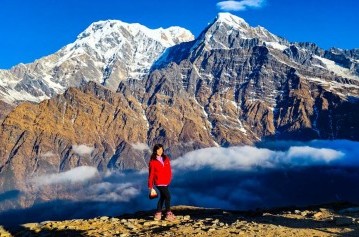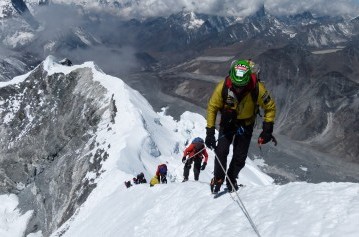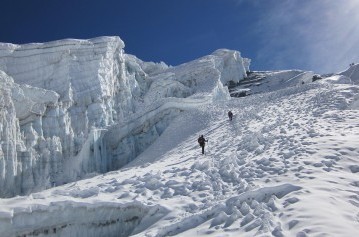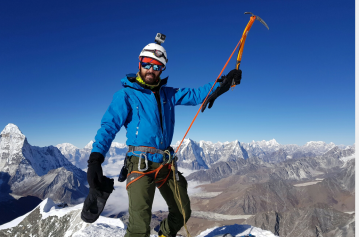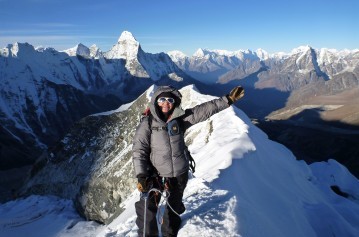"Nepal - Paradise for Travelers"
Nepal is a country of amazing extremes, from the Terai lowland barely of 60m from the sea level to the highest point of the earth - Mount Everest at 8848m. Nepal is a landlocked country which lies in the South Asia in border with Tibet Autonomous Region of China to the north and India to the east, west and south. Nepal has variation in demographic, culture, ethnicity, different natural beauty on every state, which makes Nepal one of the leading trekking destinations in the world. From south to North, there is subtropical jungle through the terraced hillsides of the Himalayan foothills up through pine and rhododendron forests and to the peaks and glaciers of the great Himalayan Range which forms the northern border with Tibet. Kathmandu is the capital city of Nepal. Nepal is officially the Federal Democratic Republic of Nepal and secular nation with the diversity of Hindu, Buddhist, Christian and Muslim people. Nepal is a multi-lingual, multi-ethnic, multi-religious and multi-cultural country which gives another reason for travellers to explore around Nepal.
The mountains of Nepal are the peak attractions. Nepal has 8 out of 14 highest mountains in the world which are: Mount Everest (8848 m), Mount Kanchenjunga (8598 m), Mount Lhotse (8516 m), Mount Makalu (8463 m), Mount Cho Oyu (8201 m), Mount Dhaulagiri (8167 m), Mount Manaslu (8163 m) and Mount Annapurna (8091 m). With the tallest mountains, Nepal also has many popular peaks above 6000 meters like: Island Peak (6189 m), Mera Peak (6461 m), Lobuche Peak (6119 m), Chulu West (6419 m), Thorang Peak (6144 m), Thapa Peak (6012 m) and many more. Nepal is a top choice amongst the travellers who want to do expeditions in the high mountain as well as for the peak climbers who want to reach to the summit of the peak.
Nepal is not only enriched with tallest mountains; we also have 36 different ethnic culture which varies from each region of Nepal. We can experience the unique and warm culture as we explore east to west region of Nepal. The linguistic heritage has been evolved from three different language groups like: Indo-Aryan, Tibeto-Burman and Indigenous. Also, the different culture offers different architect, religion, music and literature. Nepal is divided in three layers as per the geographical settings: Himalayan, Hilly and Terai. We can experience different culture, people, habitants in each region of Nepal.
NEPAL AT A GLANCE:
Area: 147,181 sq.km.
Geography: Situated between Tibet Autonomous Region of China to the north and India to the east, west and south.
Capital city: Kathmandu
Total Population: 29.67 million (2021)
National Language: Nepali
Currency: Nepalese Rupee (NPR)
Religion: Secular Nation (harmonious blending of Hinduism and Buddhism)
Ethnic groups: 125 different ethnic groups and 123 spoken languae
Political System: Multiparty Democratic System
Geographical Region: Himalayan, Mid Hill and Terai (flat plains)
GEOGRAPHY OF NEPAL
Himalayan Region: The high mountain ranges in the Himalayan Region varies with elevation from 4000 meters to 8848 meters above sea level. This region comprises about 15% of Nepal's total area. Himalayan Region of Nepal has eight of the world's fourteen highest mountains of above 8000 meters. The massive Mount Everest (8848 meters), Mount Kanchenjunga (8586 meters), Mount Manaslu (8163 meters), Mount Lhotse (8516 meters), Mount Makalu (8481 meters), Mount Cho Oyu (8188 meters), Dhaulagiri I (8167 meters), and Mount Annapurna I (8091 meters) are the eight thousanders of Nepal's Himalayan area. The Himalayan area is home to the breathtaking Himalayan range, and the region's climate is quite cold. The Himalayan Region is famous for different trekking routes: Everest Base Camp, Annapurna Circuit, Kanchenjunga, Makalu Barun National Park, Dhaulagiri Circuit, and other destinations. In the Himalayan region, many peak climbing is also popular: Mera Peak, Pisang Peak, Island Peak, Chulu West, Chulu East, Thorang Peak, Pachermo Peak, and so on. With that, in the Himalayan Region we organize expeditions such as the Everest, Manaslu, Annapurna, and so on. Himalayan region is also abundant in plants and fauna, as evidenced by the possibility of seeing Himalayan Yaks, Danphe birds, and snow leopards, among other species. Furthermore, nutrient-dense plants like Yarsha gumba and others are available.
Hilly Region: Hilly region of Nepal covers about the 68% of Nepal’s territory which is the largest area as well as the region comprises of highest population. The temperature of the hilly region is mild and land on this region is more fertile as compared to Himalayan Region. Kathmandu, capital city of Nepal is located in hilly region. Also, other famous destination like Kathmandu, Nagarkot, Dhulikhel, Pokhara, Bandipur, Tansen, Ilam and so on.
Terai Region: Terai Region covers about 17% of total Land of Nepal which covers the far – west to the far east including the whole southern part of the country. Terai region lies in the lowest altitude which is 70m above from the sea level. The weather is overall hot in summer and cold in morning and night in winter. Terai Region has a sub-tropical climate and Terai is known as the food grain of Nepal as here the land is extremely fertile and has the capacity for maximum food grains for overall country’s population. Terai has the popular destinations of Nepal like Lumbini, Chitwan, Bardia, Janakpur and so on. The birth place of Gautam Buddha (Lumbini), Chitwan National Park of Chitwan, Bardia National Park of Bardia, Koshi Tapu Wildlife Reserve of Bardia and Janaki Temple (Mandir) of Janakpur are the famous wildlife and historic places where maximum tourist visit each year. Bardia National Park of Terai region is one of the largest and most undistributed national parks of Nepal. The wildlife like one horned Rhinoceros, Royal Bengal Tiger, Gharial crocodile, Gangetic dolphins along with different species of birds and animals can be explored in Bardia and Chitwan National Park of Terai.
CLIMATE OF NEPAL
Nepal experience 5 different seasons and the climate varies from Himalayan to Terai Region.
Spring season (March – April) is known as Basanta Ritu in Nepal which is the prettiest season where flower blooms, and the weather is warm (neither too hot or cold). This is one of the best seasons for trekking and climbing mountains where we can observe the beautiful view of jungle with vivid textures of flowers and fauna as well as perfect weather for trekking, peak climbing and mountain expeditions.
Summer season (May – June) is the hottest season in overall Nepal. The weather is hot in May and June. However, Trekking is possible in Himalayan Region of Nepal in May and June. But summer season is not preferable season for trekking in Nepal as there are chances of Rain in the summer season. But the trekking can be done in Rain shaded regions of Nepal.
Monsoon season (July – August) is the rainy as well as summer in Nepal. We can experience maximum rain or monsoon during the month of July and August. Trekking in the Himalayan region of Nepal might not be best idea during monsoon season as there is chances of slippery and muddy roadways along with the views covered by the clouds and there are chances of landslides as well. But in Monsoon season maximum travellers travel to the destination like Mustang / Upper Mustang, Dolpo Region, Manang (Annpurna Circuit), Nar Phu and Badimalika Trek. Mustang, Dolpo, Manang, Nar Phu are the rain shaded areas of Nepal. Trekking in these regions is perfect during the monsoon season in Nepal.
Autumn Season (September – November) is the peak season for trekking in Nepal. The weather is perfect and stable as temperature is mild (not so cold and not so hot) and we can see the beautiful views of Himalayas while trekking in the Himalayan region in Autumn season. During Autumn on the month of October Nepali people also celebrate their biggest festival, Dashain and Tihar. The holiday season with perfect climate and weather makes this season one of the best seasons for travelling in overall Nepal. We can see many tourists in almost all parts of Nepal during Autumn season.
Winter Season (December – February) is the cold season where temperature can range between 9 – 12 degrees delicious. We start to see the snow fall and freezing lakes at the high altitude of Nepal during winter. The people living in high altitude start to come down during winter season of Nepal. Trekking in Himalaya will be very cold during winter. But winter season is suitable for those who wants to do the tour like: Heritage tour, Cultural tour, Buddhist tour and so on. Also, easy treks like Annapurna Base Camp Trek, Ghorepani Poonhill Trek, Mardi Base Camp Trek, Kori – Sikles Trek, Langtang – Gosaikunda Trek and Langtang Valley Trek are possible in winter season. With the help of guide and warm clothes and sleeping bags trekking can be done and in winter these destinations.
HIGHLIGHTS OF NEPAL
- World’s highest mountain, Mount Everest (8848.46 m) lies in Nepal
- Country with 8 highest mountains in the world
- The light of Asia, ‘Lord Buddha’s’ was born in Lumbini of Nepal
- Paradise for trekking
- The Kumari, only living goddess is worshipped in Nepal during festival of Indra Jatra
- Religious monuments, temples of Kathmandu city (capital of Nepal)
- UNESCO Listed World Heritage Sites: Kathmandu Durbar Square, Swoyambhunath, Boudhanath, Pashupatinath, Bhaktapur Durbar Square, Changunarayan, Patan Durbar Square, Everest National Park..
- The deepest Gorge in the world, Kali Gandaki River Gorge
- Upper Mustang of Nepal, listed as must visit place by the CNN Reports, 2023
- One horned Rhinoceros of Chitwan National Park
- The best 10 Rivers in the world for Rafting
- The art, culture, ethnic groups, Sherpas of Nepal, diverse culture living in harmony with each other of Nepal is something which cannot be found else in world
- Nepal is country with only non – rectangular national flag in the world
For the memorable travel journey, Nepal is a once in lifetime opportunity to visit. In Nepal you can make your most memorable and lifetime trip. Asian Adventure offers affordable and best tailor made as well as customized travel / trekking / tour / peak climbing / expeditions packages from east to west of Nepal. Inquire us for booking and queries.
Featured trips for "Nepal - Paradise for Travelers"
Easy trekking are basically for the beginners. This kind of treks is typically done in the lower hilly region of elevation below 3500 metre. The trails in this trek are generally vertical and walking time is 3 - 5 hours everyday.
Moderate types of trekking generally take place on the low altitude zone crossing the passes below the elevation of 4500 meters. Normally the walking is from 4 - 6 hours each day.
Hard kind of trekking routes crosses through the wild and adventurous trails and sometimes passes through the snow covered high passes between 4500 meters to 5500 meters. Usually the walks takes from 7-8 hours everyday.
Generally this types of routes are demanding long distance treks where the walks takes up to 9 hours each day. Each trail crosses at least one pass over 5500 meters frequently contains hardly ever explored regions. Challenging are the expedition types of activity.

